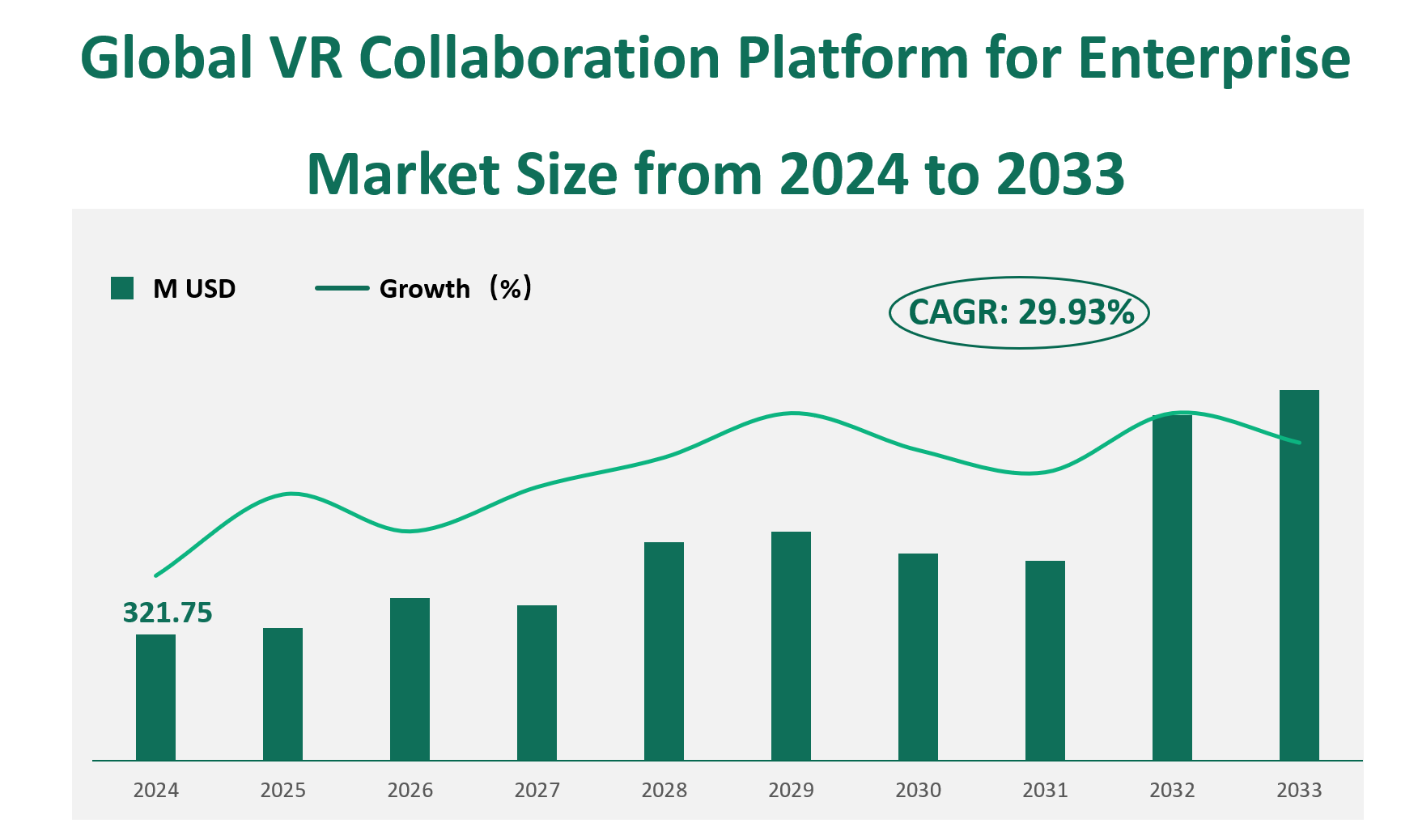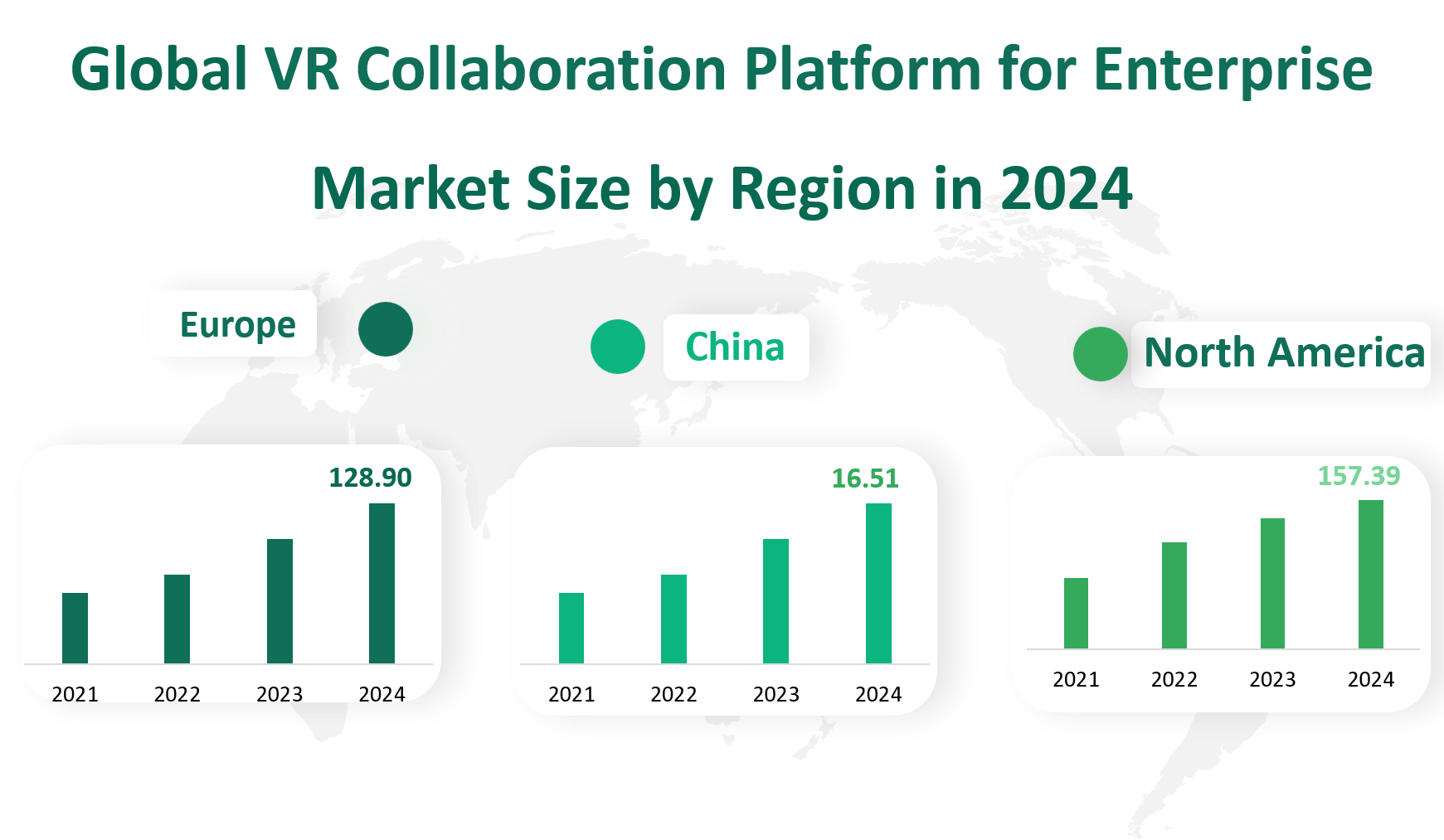1. Global VR Collaboration Platform for Enterprise Market Insight Analysis
The global VR Collaboration Platform for Enterprise market revenue is 321.75 million USD in 2024, with a Compound Annual Growth Rate (CAGR) of 29.93% from 2024 to 2033.
A VR Collaboration Platform for Enterprise is a sophisticated technological solution that enables users to collaborate in virtual reality from remote locations. These platforms allow teams to meet in shared virtual spaces, facilitating communication through speech and text. Users can select and customize avatars to represent themselves and choose from a variety of virtual environments to host meetings. The platforms offer a range of interactive features, including virtual presentations, design visualization, and collaborative tools for team projects.
This technology is particularly beneficial for enterprises with a geographically dispersed workforce, as it enhances remote employees’ ability to work effectively with their colleagues. The platforms can be deployed across multiple users simultaneously, ensuring seamless collaboration regardless of physical location. Additionally, VR collaboration platforms often provide the capability to record and playback virtual meetings, further enhancing their utility in a business environment.
Figure Global VR Collaboration Platform for Enterprise Market Size (M USD) and CAGR (2024-2033)

2. Driving and Limiting Factors of VR Collaboration Platform for Enterprise Market Growth
The growth of the VR Collaboration Platform for Enterprise market is driven by several key factors. Firstly, the increasing demand for remote collaboration tools has been significantly accelerated by the COVID-19 pandemic. As companies worldwide adapted to remote work, the need for immersive and effective collaboration solutions became paramount. VR platforms offer a more engaging and interactive alternative to traditional video conferencing, addressing the limitations of two-dimensional communication.
Secondly, technological advancements in VR hardware and software have made these platforms more accessible and user-friendly. The development of high-resolution VR headsets and powerful cloud-based solutions has improved the overall user experience, making VR collaboration a viable option for a broader range of enterprises.
However, there are also several limiting factors that could hinder the widespread adoption of VR collaboration platforms. One significant challenge is the high cost of VR hardware, which can be prohibitive for many enterprises, especially small and medium-sized businesses. The initial investment required for VR headsets and compatible devices can be substantial, and the return on investment may not be immediately apparent.
Additionally, the current state of network infrastructure in many regions may not support the high bandwidth and low latency required for seamless VR experiences. This can lead to performance issues such as lag and poor video quality, which can negatively impact user satisfaction and adoption rates. Furthermore, the complexity of integrating VR platforms with existing enterprise systems and workflows can pose a significant barrier. Companies may face challenges in ensuring compatibility and data security, which can slow down the implementation process.
3. Technology Innovation and Corporate Mergers and Acquisitions in VR Collaboration Platform for Enterprise Market
The VR Collaboration Platform for Enterprise market is characterized by continuous technological innovation and strategic corporate activities. Companies in this space are constantly working to enhance the performance and functionality of their platforms. For example, advancements in 360-degree video technology are providing users with more immersive and realistic experiences. The development of more user-friendly interfaces and the integration of AI-driven features, such as automated meeting transcription and real-time language translation, are also key areas of focus. These innovations aim to improve the overall usability and efficiency of VR collaboration platforms, making them more attractive to enterprises.
Corporate mergers and acquisitions are also playing a significant role in shaping the market landscape. Major players are seeking to expand their market share and enhance their technological capabilities through strategic partnerships and acquisitions. For instance, Autodesk’s acquisition of The Wild in 2022 demonstrates the company’s commitment to strengthening its position in the VR collaboration space. This acquisition allows Autodesk to integrate advanced VR solutions into its existing portfolio, providing a more comprehensive offering for its customers.
4. Global VR Collaboration Platform for Enterprise Market Size by Type
Virtual Reality (VR) Collaboration Platforms are revolutionizing the way enterprises collaborate by providing immersive, interactive environments that bridge the gap between remote and in-person interactions. These platforms allow users to meet in virtual spaces, interact through avatars, and share content in real-time. The market for VR Collaboration Platforms for Enterprise is segmented into two primary product types: Cloud-based and On-premises solutions.
Cloud-based VR Collaboration Platforms are hosted remotely by third-party servers, providing users with access to virtual collaboration spaces through the internet. This type of platform offers several advantages, including cost savings, improved productivity, and enhanced security. Users can access the platform from anywhere, making it ideal for enterprises with a geographically dispersed workforce. The flexibility and scalability of cloud-based solutions make them particularly attractive for large enterprises and small to medium-sized enterprises (SMEs) alike.
In 2024, the market revenue for Cloud-based VR Collaboration Platforms is projected to be significantly higher than that of On-premises solutions. This is due to the growing demand for scalable, flexible, and cost-effective collaboration tools that can be easily integrated into existing workflows. The market revenue for Cloud-based platforms is expected to reach $245.96 million, accounting for approximately 76.44% of the total market revenue.
On-premises VR Collaboration Platforms are installed and managed within the enterprise’s own infrastructure. This type of solution offers greater control over data security and customization, making it suitable for enterprises with stringent security requirements. However, On-premises solutions require significant upfront investment and ongoing maintenance costs. In 2024, the market revenue for On-premises VR Collaboration Platforms is projected to be $75.79 million, representing 23.56% of the total market revenue.
Table Global VR Collaboration Platform for Enterprise Market Size by Type in 2024
5. Global VR Collaboration Platform for Enterprise Market Size by Application
The VR Collaboration Platform for Enterprise market serves a wide range of applications, primarily categorized into Large Enterprises and Small and Medium-sized Enterprises (SMEs). These platforms provide immersive and interactive collaboration experiences that enhance productivity and communication across various industries.
Large Enterprises typically employ 250 or more people and often require robust, scalable solutions to support their extensive workforce. VR Collaboration Platforms offer these enterprises the ability to conduct virtual meetings, collaborate on complex projects, and provide remote training in a highly immersive environment. The platforms enable employees to interact through avatars, share 3D models, and visualize designs in real-time, significantly enhancing decision-making processes. In 2024, the consumption value for Large Enterprises using VR Collaboration Platforms is projected to be $276.12 million.
SMEs, which employ fewer than 250 people, also benefit from VR Collaboration Platforms. These platforms provide SMEs with the tools to compete with larger enterprises by offering immersive collaboration experiences that can bridge geographical gaps and improve communication. SMEs can use these platforms for virtual meetings, project collaboration, and even customer presentations. In 2024, the consumption value for SMEs using VR Collaboration Platforms is projected to be $45.64 million.
Table Global VR Collaboration Platform for Enterprise Market Size by Application in 2024
Application | Market Size (M USD) 2024 | Market Share |
Large Enterprises | 276.12 | 85.82% |
Small and Medium Enterprises (SMEs) | 45.64 | 14.18% |
6. Global VR Collaboration Platform for Enterprise Market by Top Regions
North America continues to lead the VR Collaboration Platform for Enterprise market in terms of revenue. In 2024, the region is projected to generate a market revenue of $157.39 million, accounting for approximately 49.03% of the global market. This dominant position is attributed to the region’s advanced technological infrastructure, high adoption rates of VR technologies, and a concentration of major technology companies. The United States has been at the forefront of VR innovation, with companies like Autodesk and Glue leading the market
Europe is the second-largest market for VR Collaboration Platforms, with a projected revenue of $128.90 million in 2024, representing 39.26% of the global market. The region’s strong market position is supported by its robust technology sector, particularly in countries like Germany, the UK, and France. European enterprises are increasingly adopting VR platforms to enhance productivity and collaboration, especially in sectors such as architecture, engineering, and construction.
China is the fastest-growing market for VR Collaboration Platforms, with a projected revenue of $16.51 million in 2024. This represents a significant growth rate compared to other regions, driven by the rapid technological advancements and increasing demand for VR solutions. The region’s growth is also supported by the increasing adoption of VR technologies in industries such as manufacturing, healthcare, and education.
Figure Global VR Collaboration Platform for Enterprise Market Size by Region in 2024

7. Global VR Collaboration Platform for Enterprise Market Analysis by Major Players
7.1 Autodesk
Company Introduction and Business Overview
Autodesk is a leading design software company that serves customers across various industries, including manufacturing, architecture, building, construction, media, and entertainment. Founded in 1982, Autodesk has been at the forefront of technological innovation, particularly in the areas of robotics, Augmented and Virtual Reality (AR/VR), and 3D printing. The company’s mission is to empower everyone to design and make anything, with a focus on creating more sustainable and efficient solutions.
Products Offered
Autodesk offers a range of VR collaboration tools, including The Wild, an immersive collaboration platform that enables teams to experience work together in a shared virtual space. The Wild integrates seamlessly with Autodesk’s Construction Cloud, providing users with real-time collaboration and visualization capabilities. The platform supports Revit and BIM 360 Docs, making it an ideal solution for architecture, engineering, and construction (AEC) professionals.
Sales Revenue in 2022
In 2022, Autodesk’s revenue from its VR Collaboration Platform for Enterprise was $5.73 million.
7.2 Glue
Company Introduction and Business Overview
Glue is a modern collaboration platform designed to bring remote teams together in a way that mimics face-to-face interactions. Founded in 2016 and based in Finland, Glue combines immersive 3D graphics, virtual reality, and cloud computing to empower teams to maximize their collaborative potential. The platform is particularly popular in Europe, where it has gained significant market share.
Products Offered
Glue offers a comprehensive VR collaboration platform that includes features such as virtual meeting rooms, real-time collaboration tools, and immersive 3D environments. The platform allows users to interact through avatars, share documents, and visualize designs in a virtual space. Glue’s platform is designed to be user-friendly and accessible, making it suitable for a wide range of industries.
Sales Revenue in 2022
In 2022, Glue’s revenue from its VR Collaboration Platform for Enterprise was $6.28 million.
7.3 ImmersedVR
Company Introduction and Business Overview
ImmersedVR, founded in 2017 and based in the United States, is a company dedicated to providing immersive VR collaboration solutions. The company’s mission is to help distributed teams achieve the same level of productivity as in-person interactions by immersing them into a virtual workplace. ImmersedVR’s platform is designed to be highly customizable, allowing users to create virtual spaces that fit their specific needs.
Products Offered
ImmersedVR offers a range of VR collaboration tools, including immersive meeting rooms, virtual whiteboards, and multi-screen sharing capabilities. The platform supports both solo and collaborative modes, enabling users to work independently or in teams. ImmersedVR’s platform is particularly popular among enterprises seeking to enhance remote collaboration and improve productivity.
Sales Revenue in 2022
In 2022, ImmersedVR’s revenue from its VR Collaboration Platform for Enterprise was $4.50 million.

